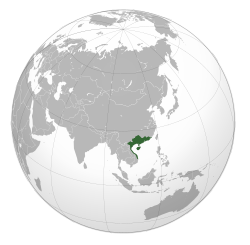Lingnan
Lingnan
岭南 | |
|---|---|
 Maximum extent of the Nanyue kingdom, roughly corresponding to the geographical region of Lingnan with the exception of Central Vietnam | |
| Modern day-location | Guangdong, Guangxi, Hainan, Hong Kong, Macau, and North Vietnam (Tonkin) |
Lingnan (simplified Chinese: 岭南; traditional Chinese: 嶺南; pinyin: lǐng nán; Jyutping: ling5 naam4; lit. 'South of the [Nanling] Mountains'; Vietnamese: Lĩnh Nam) is a geographic area referring to the lands in the south of the Nanling Mountains. The region covers the modern Chinese subdivisions of Guangdong, Guangxi, Hainan, Hong Kong & Macau[1][2] and Northern Vietnam.
Background
The area was inhabited by the Baiyue and was the base of the ancient kingdom of Nanyue. At that time, Lingnan was considered by the ancient Chinese court to be a tropical barbarian land that had no contact with the Zhongyuan, which was the cultural cradle of Chinese culture.
In the second century BCE, the Han conquest of Nanyue led to its absorption into the Han dynasty during its southward expansion, and its development was boosted once the Mei Pass was paved. The region was also the base of the Kingdom of Southern Han (917–971).[3]
Lingnan Jiedushi
Lingnan Jiedushi or military command, were ruled by military governors during the Tang dynasty.
List of jiedushis:
- Song Jing 716
- Zhen Dan 717
- Pei Zhouxian 719-722
- Li Ju 727-735
- Li Shangyin 727
- Li Chaoyin 733-735
- Song Ding 739
- Pei Dunfu 745
- Peng Guo 745-747
- Lu Huan 749-751
- Zhang Jiugao 751-753
- A Lüguang 754-756
- Helan Jinming 756
- Wei Lijian 757-758
- Zhang Wanqing 758-760
- Zhao Liangbi 760-761
- Zhang Xiu 763
- Yang Shenwei 764-767
- Xu Hao 767-768
- Li Mian 768-772
- Li Chongben 772-773
- Lu Sigong 773
- Li Shu 775
- Gao Yun 776-777
- Zhang Boyi 777-782
- Yuan Xiu 782-784
- Du You 784-787
- Li Fu 787-792
- Xue Jue 792-795
- Wang E 795-801
- Zhao Zhi 801-802
- Xu Shen 802-806
- Zhao Chang 806-808
- Yang Yuling 808-810
- Zheng Yin 810-813
- Ma Zong 813-816
- Cui Yong 817
- Kong Kui 817-820
- Cui Neng 820-823
- Zheng Quan 823-824
- Cui Zhi 824-826
- Hu Zheng 826-828
- Li Xian 828-829
- Cui Hu 829-830
- Li Liang 831-833
- Cui Gong 833
- Wang Maoyuan 833-835
- Li Congyi 835-836
- Lu Jun 836-840
- Cui Guicong 844-845
- Lu Zhen 845-846
- Li Pin 847-848
- Li Xingxiu 848-849
- Wei Zhengguan 849-851
- Ge Ganzhong 851-854
- Wei Shu 855-858
- Yang Fa 858
- Li Sui 858
- Li Chengxun 858-859
- Xiao Fang 859-860
- Wei Zhou 861-868
- Zheng Yu 868-871
- Zheng Congdang 871-874
- Wei He 874-876
- Li Tiao 877-879
- Zheng Xu 879-886
- Lü Yongzhi 886
- Pei Qu 887-889
- Li Chonggui 890-895
- Chen Pei 893
- Cui Yin 896
- Li Zhirou 896-900
- Cui Yin 900
- Xu Yanruo 900-901
- Liu Yin 901-911
- Pei Shu 903
- Cui Yuan 904
- Liu Yan 911-917
See also
References
- ^ Guo, Jie; Zuo, Pengjun (2018). 岭南文化研究. 清華大學出版社. ISBN 9787302399476.
- ^ Xie, Xuanjun (2015). 辛亥革命百年透视 现代南北朝的曙光. Lulu.com. p. 527. ISBN 9781329581210.
- ^ "Social and Clan Culture in the Lingnan Region". Shvoong.com. Archived from the original on October 6, 2008. Retrieved June 20, 2012.
